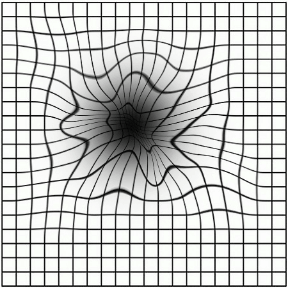The Amsler grid is a very easy way to check regularly for changes in your vision to determine if you require urgent review with your eye specialist. It can help you to remain on top of your own eye health by helping you monitor your own changes in vision. Early detection of visual issues is vital in effectively treating and managing them.
Developed by Marc Amsler, a Swiss ophthalmologist, the Amsler Grid has been used since 1945 to help detect and diagnose vision loss or distortion. The grid is made up of black lines, usually presented on a white background. In the centre of the grid is a large black dot.
You can download a copy of the Amsler grid here to conduct your own vision tests at home.
How often should I use the Amsler grid?
Frequent testing helps with early detection, so make it a habit to check regularly.
Many people find that printing out a copy of the Amsler grid and attaching it to their refrigerator (or another highly visible place) is a great way to help them remember.
Your healthcare provider may recommend daily or weekly use of the grid test. You may also use this test for family and friends who have suspected vision loss.
What conditions can the Amsler grid diagnose?
The Amsler Grid can make it easier to see visual disturbances caused by changes in the macula, and certain optic nerve conditions. This makes the test great for detecting conditions such as macular degeneration, epiretinal membrane, and other eye disorders.

How do I use the Amsler Grid?
Using the Amsler grid is an easy way to self-check your eyes for signs of vision disorders at home.
Before you take the test, make sure you have the necessary equipment. You will need a copy of the Amsler Grid and any reading glasses that you typically use. The Amsler Grid can be viewed on a screen or in print, but it needs to be 10-20cm in size to work effectively. This means you may not be able to take the test on a very small screen (like a small mobile phone).
Hold the chart away from your face at the distance you would generally read from (usually about 30-40cm). Cover one eye and focus on the black dot in the centre of the grid. Take note of what you see: if your eyes are healthy, the lines should appear straight and clear, and the grid should appear complete with no blurring, discolouration, or patches missing. Switch eyes and repeat the test, making note of any abnormalities you see.
Do I need to see an eye specialist?
Any abnormality that appears in the Amsler Grid test is cause for medical investigation.
Wavy, fuzzy, dim, or otherwise irregular lines and parts of the grid and boxes appearing to have dark spots, missing parts, or to be faded, blurred, swirling, or larger in some places are common warning signs for an underlying eye condition. If you experience any of these signs, see your GP or an optometrist for a referral to an ophthalmologist. Be sure to mention your Amsler test results.
About Westside Eye Clinic
Westside Eye Clinic is a specialist Ophthalmology practice located in Jamboree Heights near the Mt Ommaney Shopping Centre, in the Western Suburbs of Brisbane.
Dr Joseph Park is a Specialist Ophthalmologist (an Eye Doctor) who trained in Brisbane and undertook further studies at Moorfields Eye Hospital and Western Eye Hospital in London, United Kingdom.
